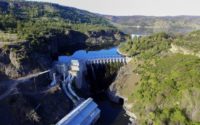A Nov. 17 pact among key stakeholders in the long-controversial and much-delayed removal of four Klamath River dams in Oregon and California is set to move the estimated $446-million project past yet another sticking point. The largest-ever U.S. dam removal project will allow the river to flow freely, with fish passage restored.
Governors of the two states signed a memorandum of agreement with two Native American tribes, utility owner PacifiCorp and a successor nonprofit removal firm, Klamath River Renewal Corp. (KRRC), which settles project financial concerns raised in July by the Federal Energy Regulatory Commission.
Under the new agreement, PacifiCorp will be removed from the dams' operating license, with California, Oregon and KRRC added as co-licensees for dam removal execution. KRRC submitted to FERC last March a guaranteed maximum price of $446 million for the project, with a $50-million contingency.
“Adding the states as co-licensees provides assurances that the project will have sufficient financial backing while honoring settlement terms that stipulate PacifiCorp would not be a co-licensee for removal,” said a statement by California Gov. Gavin Newsom. The firm had been concerned that remaining as a licensee could have increased costs to its ratepayers beyond the agreed $200 million.
The parties also agree to nearly double contingency funds held by KRRC and contractors. If insufficient, California, Oregon and PacifiCorp will share costs equally, a provision that meets FERC requirement to ensure full project funding.
The new pact now implements dam removal under a 2016 settlement among the parties, for a project start in 2022, with removal work the next year and site remediation and restoration to follow, pending final regulatory approval.
Kiewit Infrastructure West Co. was selected in 2019 as the project's design-build contractor, awarded an initial $18.1-million contract for the first 12 months of preliminary services, with the value increased to $28.3 million to complete design services and permitting efforts, says Dave Meurer, community liaison for KRRC.
“The construction contract is expected to be over $200 million, and the plan is to sign the amendment authorizing construction after all permits are obtained,” says Meurer, who does not believe the agreement will have a direct impact on Kiewit other than providing clarity on the dam-removal timeline. “It is full speed ahead," he says.
“This job has many similarities to other complex water and hydroelectric projects that we’ve successfully delivered across North America,” says Jeff Petersen, Klamath project director at Kiewit Infrastructure West. “We look forward to safely completing this project for the local communities, tribes and the salmon population.”
Knight Piesold is the project engineer and Resource Environmental Solutions is the lead for restoration design and construction.





Post a comment to this article
Report Abusive Comment